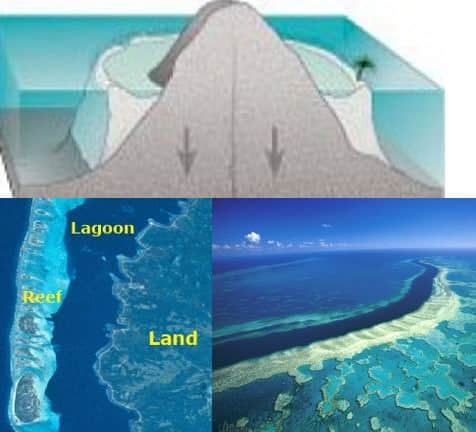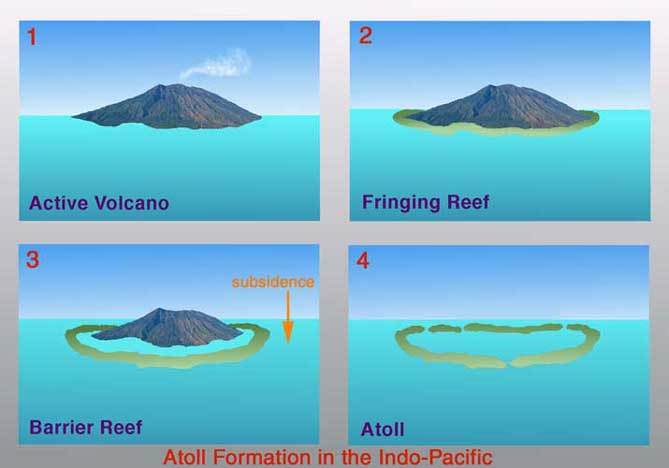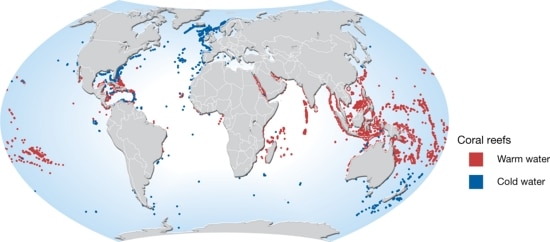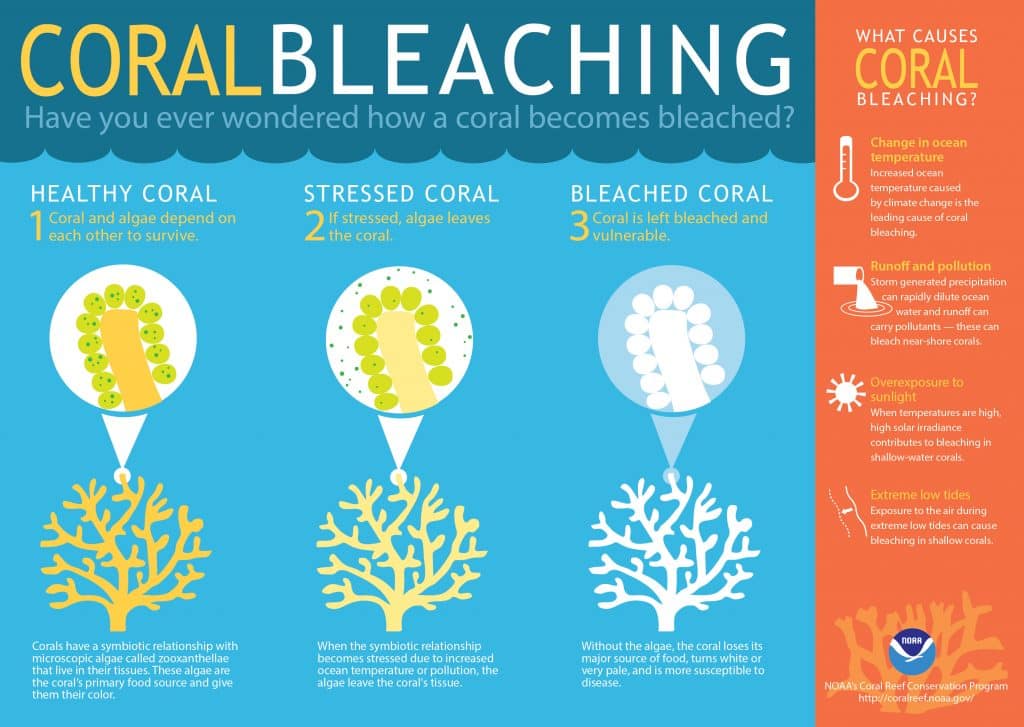- Corals are nothing but calcareous rocks, formed from the skeletons of minute sea animals, called polyps.
- The polyps extract calcium salts from seawater to form hard skeletons which protect their soft bodies. These skeletons give rise to corals.
- The corals live in colonies fastened to the rocky seafloor. New generations develop on skeletons of dead polyps. The tubular skeletons grow upwards and outwards as a cemented calcareous rocky mass collectively called corals.
- The shallow rock created by these depositions is called a reef. These reefs, later on, evolve into islands.
- The corals Occur in different forms and colours, depending upon the nature of salts or constituents they are made of.
- The progressive development of corals appears over the sea surface in different forms over a period of time. Small marine plants (algae) also deposit calcium carbonate, thus contributing to coral growth.

Ideal conditions for coral growth
- Corals thrive in tropical waters-between 30°N and 30°S latitudes.
- The ideal depths for coral growth are 45 m to 55 m below sea surface, where there is abundant sunlight available.
- The temperature of water should be around 20°C.
- Clear salt water is suitable for coral growth, while both fresh water and highly saline water are harmful for polyp growth.
- Adequate supply of oxygen and microscopic marine food, called plankton, is essential for growth and existence. As the food supply is more abundant on the seaward side, corals grow more rapidly on the seaward side.
Types of Coral Reefs
- Coral reefs can be classified on the basis of large-scale reef morphology; the size and shape of a reef, and its relation to nearby land (if any).
- This is usually (but not always) sufficient to clearly distinguish one type from the others.
- There is often a great deal of overlap among the major reef types (within a given biogeographic region) in terms of the dominant groups of animals and plants, as well as their ecological interactions.
- There are three major types of coral reefs: Fringing Reef, Barrier Reef, and Atoll :
Lagoon
Lagoon – as used in the context of coral reef typology – refers to a comparatively wide band of water that lies between the shore and the main area of reef development, and contains at least some deep portions.
Fringing Reef
- It is by far the most common of the three major types of coral reefs.
- It is a coral platform attached to a continental coast or an island, sometimes separated by a narrow, shallow lagoon or channel.
- A fringing reef runs as a narrow belt, 0.5 km to 2.5 km wide.
- This type of reef grows from the deep sea bottom with the seaward side sloping steeply into the deep sea.
- Coral polyps do not extend outwards because of sudden and large increases in depth.
- The surface of a fringing reef is rough, as it is covered with coral remains forming a boulder zone or reef flat.

Barrier Reef
- This is the largest of the three reefs, runs for hundreds of kilometres and is several kilometres wide.
- It extends as a broken, irregular ring around the coast, or an island, running almost parallel to it.
- A barrier reef is characterized by the distant location of the reef from the coast with a broader and deeper lagoon, which is sometimes joined with the seawater through one or more channels cutting across the barrier reef.
- A barrier reef is very thick, going even below 180 metres from the surface with the seaward side sloping steeply into the deep sea. The surface of a barrier reef is covered with coral debris, boulders, and sand.
- The most famous example of this type of reef is the Great Barrier Reef off the coast of northeastern Australia, which is 1900 km long and 160 km wide.

Atolls
- It is a ring-like reef, which, partly or completely, encloses a lagoon. The lagoon may have a level surface, but the seaward side of the reef slopes steeply into the deep sea.
- The lagoon has a depth 80-150 metres and may be joined with seawater through a number of channels cutting across the reef.
- Atolls are located at great distances from deep-sea platforms, where the submarine features may help in formation of atolls, such as a submerged island or a volcanic cone which may reach a level suitable for coral growth.
- Atolls are far more common in the Pacific than any other ocean. The Fiji atoll and the Funafuti atoll in the Ellice Island are well-known examples of atolls. A large number of atolls also occur in the Lakshadweep islands.
- In the South Pacific, most atolls occur in mid-ocean. Examples of this reef type are common in French Polynesia, the Caroline and Marshall Islands, Micronesia, and the Cook Islands.
- The Indian Ocean also contains numerous atoll formations. Examples are found in the Maldives and Chagos island groups, the Seychelles, and in the Cocos Island group.

Formation of Lakshadweep Islands (Atoll Formation)
- The basic coral reef classification scheme described above was first proposed by Charles Darwin, and is still widely used today.
- Darwin theorized that fringing reefs began to grow near the shorelines of new islands as ecological conditions became ideal for hard coral growth.
- Then, as the island began to gradually subside into the sea, the coral was able to keep pace in terms of growth and remained in place at the sea surface, but farther from shore; it was now a barrier reef.
- Eventually, the island disappeared below the sea surface, leaving only the ring of coral encircling the central lagoon; an atoll had formed.

Distribution of Coral Reefs
- The majority of reef-building corals are found within tropical and subtropical waters. These typically occur between 30° north and 30° south latitudes.
- The Indonesian/Philippines archipelago has the world’s greatest concentration of reefs and the greatest coral diversity.
- Other areas of reef concentration are the Great Barrier Reef of Australia, the Red Sea, and the Caribbean, the latter having a much lower diversity than all major Indo-Pacific regions.
- World’s major coral reef regions:
- Caribbean/ western Atlantic
- Eastern Pacific
- Central and western Pacific
- Indian Ocean
- Arabian Gulf
- Red Sea

Coral Reefs Bleaching
- Coral reef ecosystems worldwide have been subject to unprecedented degradation over the past few decades. Disturbances affecting coral reefs include anthropogenic and natural events.
- Recent accelerated coral reef decline seems to be related mostly to anthropogenic impacts (overexploitation, overfishing, increased sedimentation, and nutrient overloading.
- Natural disturbances which cause damage to coral reefs include violent storms, flooding, high and low-temperature extremes, El Nino Southern Oscillation (ENSO) events, etc.
- Coral bleaching occurs when the relationship between the coral host and marine algae, which give coral much of their colour, breaks down. Without the marine algae, the tissue of the coral animal appears transparent and the coral’s bright white skeleton is revealed. Coral reef bleaching is a common stress response of corals to many of the various disturbances mentioned above.
- Corals begin to starve once they bleach. While some corals are able to feed themselves, most corals struggle to survive without their algae. If conditions return to normal, corals can regain their algae, return to their normal colour and survive. However, this stress is likely to cause decreased coral growth and reproduction, and increased susceptibility to disease.
- Bleached corals often die if the stress persists. Coral reefs that have high rates of coral death following bleaching can take many years or decades to recover.

Causes of Coral Bleaching
- As coral reef bleaching is a general response to stress, it can be induced by a variety of factors, alone or in combination.
- It is therefore difficult to unequivocally identify the causes for bleaching events.
- The following stressors have been implicated in coral reef bleaching events.
- Temperature
- Coral species live within a relatively narrow temperature margin and therefore, low and high sea temperatures can induce coral bleaching. Bleaching events occur during sudden temperature drops accompanying intense upwelling episodes, seasonal cold-air outbreaks etc.
- Solar Irradiance
- Bleaching during the summer months, during seasonal temperature and irradiance maxima often occurs disproportionately in shallow-living corals and on the exposed summits of colonies.
- Subaerial Exposure
- Sudden exposure of reef flat corals to the atmosphere during events such as extreme low tides, ENSO-related sea level drops or tectonic uplift can potentially induce bleaching.
- Fresh Water Dilution
- Rapid dilution of reef waters from storm-generated precipitation and runoff has been demonstrated to cause coral reef bleaching.
- Other causes includes the increase in the concentration of inorganic Nutrients, sedimentation, oxygen starvation caused by an increase in zooplankton levels as a result of overfishing, ocean acidification, changes in salinity, sea level change due to global warming, cyanide fishing etc.
- Temperature
Spatialand Temporal range of Coral Reef bleaching
- Mass coral moralities in coral reef ecosystems have been reported in all major reef provinces since the 1870s.
- The frequency and scale of bleaching disturbances has increased dramatically since the late 70’s. This is possibly due to more observers and a greater interest in reporting in recent years.
- More than 60 coral reef bleaching events out of 105 mass coral moralities were reported during 1979-1990, compared with only three bleaching events among 63 mass coral moralities recorded during the preceding 103 years.

Thanks a lot for this initiative.
Why It’s mentioned that corals are Calcerous rock rather than Marine Animals that have A body, with mouth, and stinging cells (Tentacles) to attract the prey
& Individual coral are refferd as polyps and corals in Bunch
Because dead polyps make corals
Then how is symbiotic relation possible if they’re dead ?